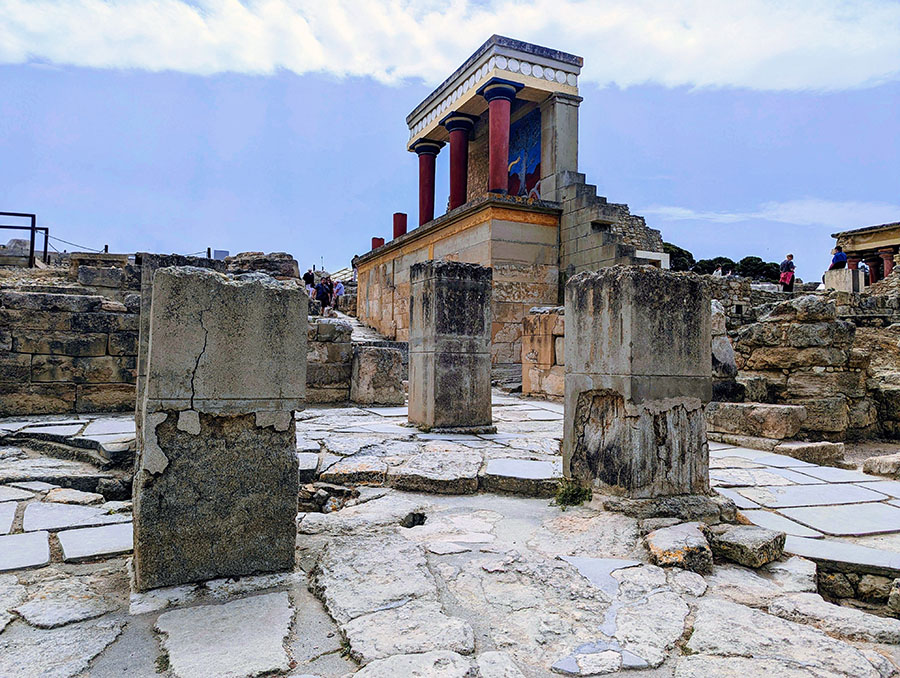
For Tourists:
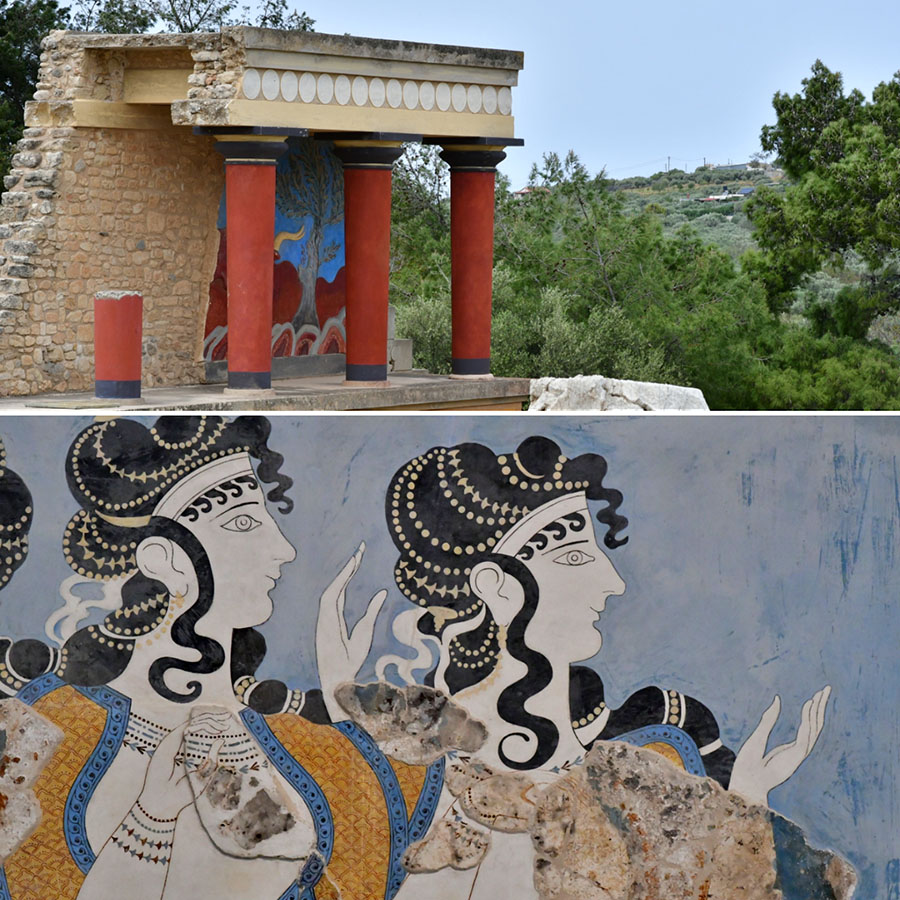
Should I visit Knossos? That’s the question I asked myself planning my trip to Greece. The Palace of Minos in Knossos is located on the outskirts of town Heraklion on the island of Crete. Here, you’ll find some historic information about the palace of Minos and its culture. While Knossos is the center of the Minoan culture that gives us valuable insight into the habits of ancient civilization, I must say that this place might not be very interesting to see for a seasoned traveler. Parts of the palace have been reconstructed to give you a better idea what it looked like, and the museum has many artifacts that were found by the archeologist Sir Evans at the ancient site.
I think the most amazing thing about Knossos is its unusual architectural design and application. Unlike other palaces in the history of humanity where royalty separated itself to live and govern in modern luxury, the Palace of Minos held many administrative, religious, entertaining and ceremonial functions inside it. The Palace appeared to have been the center of political, economic and religious authority. It also housed various people and trades in it, including artisans and merchants. The labyrinth-like structure of the palace birthed one of Greek myths about Theseus, prince of Athens who slayed the Minotaur. The Minotaur was a half-bull, half-man who lived imprisoned in a labyrinth build by King Minos, father of Ariadne. Ariadne fell in love with Theseus. It's believed that Daedalus was the architect of the labyrinth and the palace. He advised Ariadne to give a tread to Theseus to find his way back from the labyrinth. King Aegeus was Theseus’s father (hence, the Aegean sea name) who threw himself off of the cliff by a mistake. He thought that Theseus was dead because of a black sail that wasn't replaced to the white one and thus killed the king.
To get to the Palace of Minos, we used a public bus and bought a ticket in a local market shop. Greeks speak English well and can help you navigate the purchase of tickets and other things. People working at the hotels also speak English well and could be a resource for you to navigate around the island. The majority of the following information comes from the wall descriptions in the museum and archeological center of the palace of Knossos.
Video on YouTube:
Brief history of the Minoan culture on Crete, Heraklion
The archeologist, Sir Arthur Evans, did the majority of excavations in Knossos in the early 20th century. He named this ancient culture “Minoan” in accordance with ancient Greek myths that referenced King Minos ruling in the area.
Prehistoric Crete (7000 – 1100 BC): the Minoan World
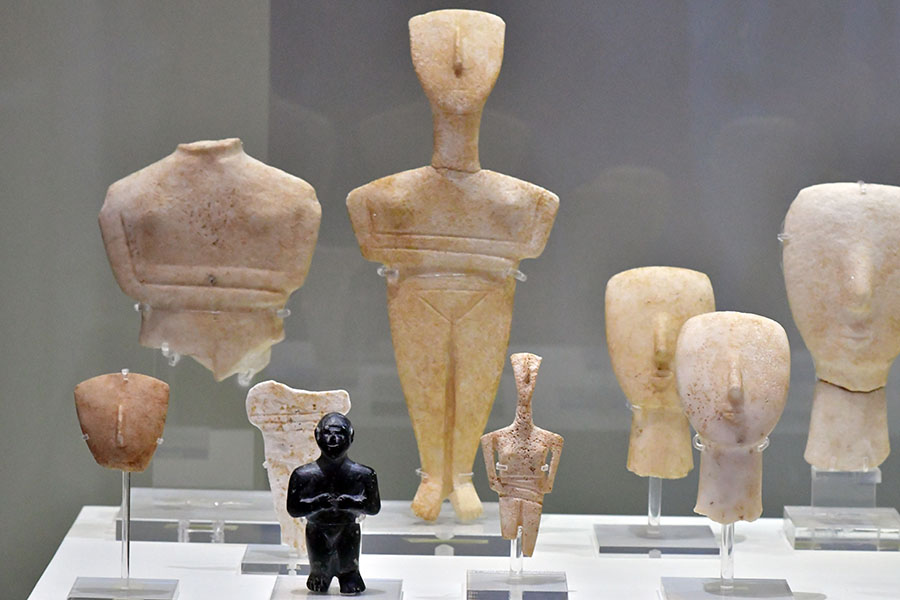
Crete has always been both a bridge and a melting pot of cultural expression, innovation and knowledge. Situated at the crossroads of the sea routes linking three continents, Asia, Africa and Europe, the Minoan world was preceded by a lengthy development, starting from the birth of Neolithic communities around 7000 BC, to the establishment of complex social structures during the course of the 3rd millennium BC.
During the Bronze Age, Cretan culture had experienced constant enrichment and renewal through interactive communication with other Aegean civilizations, Egypt and the East. This interaction created favorable conditions for the emergence of the first great urban-palatial civilization in Europe. The Minoan civilization got its name after Minos, the semi-divine king of Knossos. The ruling elites and classes rose to wealth and power through control of production and trade.
By 2000 BCE, complex urban centers like Knossos and Phaistos emerged, boasting multi-story palaces. These were large cities with a palace center. The palace became the center of authority and residence of the Court officials, and it functioned as the seat of a complex administrative bureaucracy, including gathering and processing of goods. Social structures and relationships got consolidated through secular and religious palace rituals. Minoans thrived on maritime trade throughout the Aegean and beyond, establishing themselves as a powerful trading force. Their vibrant art, depicting nature, rituals, and bull-leaping ceremonies, adorns palace walls in vivid frescoes.
Art of the Minoan Civilization:
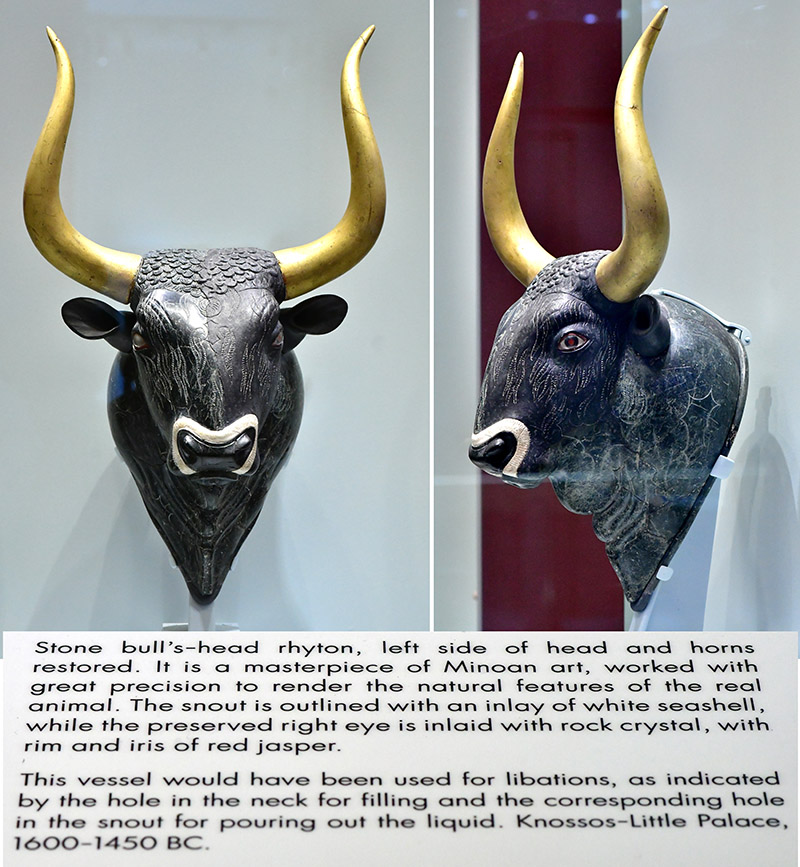
This is the bull’s head made of stone. A masterpiece of the Minoan art, it features an inlay of white seashell, rock crystal and red jasper. Carved with great precision, the bull is a vessel used for libations at the palace.
All forms of art developed and reached its peak on the island: large wall paintings, miniatures, seal-carving, jewelry-making, goldsmithing, metalwork, stone-carving and vase-painting. Increased demand for luxury and status items, which were also exported off Crete, led to the development of massive import of raw materials, such as gold, ivory, silver, copper and semiprecious stones. Minoan seafarers dominated the Aegean Sea and the East Mediterranean trading raw materials and precious art. Colonies, ports and stations of Minoan character throughout the Aegean became bases for trade overseas, while Minoan painters decorated palaces in Egypt and the East. Echoes of Cretan sea power were preserved in ancient myths of the Minoan thalassocracy.
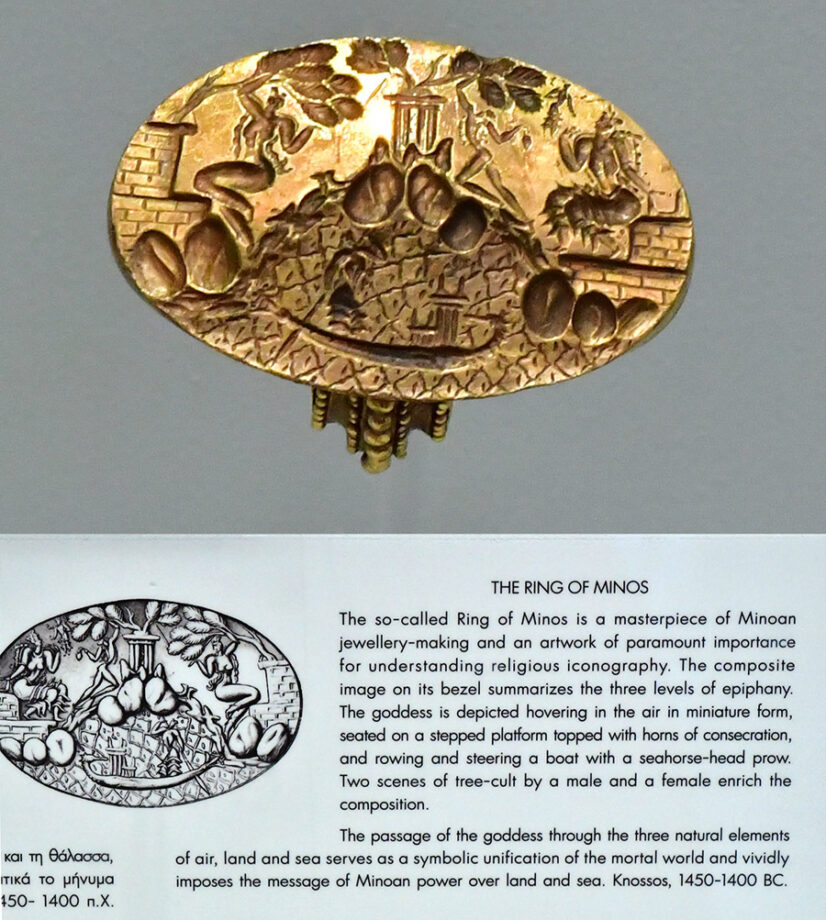
The goddess passes through 3 natural elements, air, land and sea, which becomes a symbolic unification of the mortal world. The ring’s story depicts Minoan rule and power over land and sea.
Decline of the Minoan civilization around 1450 BC:
Natural disasters that shocked the Minoan World, such as the earthquake and the cataclysmic eruption of the Thera volcano, did not cause its decline. The Minoan civilization collapsed circa 1450 BC, probably due to some internal causes. Main Minoan centers and palaces got destroyed with the exception of Knossos. As the Minoan influence waned, the mainland Mycenaean Greeks gained prominence. Mycenaean culture absorbed some Minoan elements, forming a hybrid civilization that lasted until around 1100 BCE.
New dynasties got established first at Knossos (1450-1300 BC) and then in Kydonia at Chania (1300-1250 BC). They controlled a complex bureaucracy using Mycenaean script, the first form of Greek writing. The gradual arrival of tribes from central Greece, especially from the 13th century BC onwards, led to the permanent incorporation of Crete in the cultural and political structures of the Greek world at the turn of the 2nd to the 1 millennium BC. Much about Minoan society remains a mystery, including their language (Linear A remains undeciphered). Their social structure, religious beliefs, and the reasons for their decline continue to spark debate and research.
Minoan Achievements:
- Innovative engineering with advanced water management systems and multi-story buildings.
- Developed writing systems, including Linear A and Linear B, used for administrative purposes.
- Skilled artisans crafted exquisite pottery, jewelry, and other objects. Rise of large, decorative sculpture for palaces and buildings.
- Discovered and produced expensive purple dye to color the clothes and fabric for the wealthy.
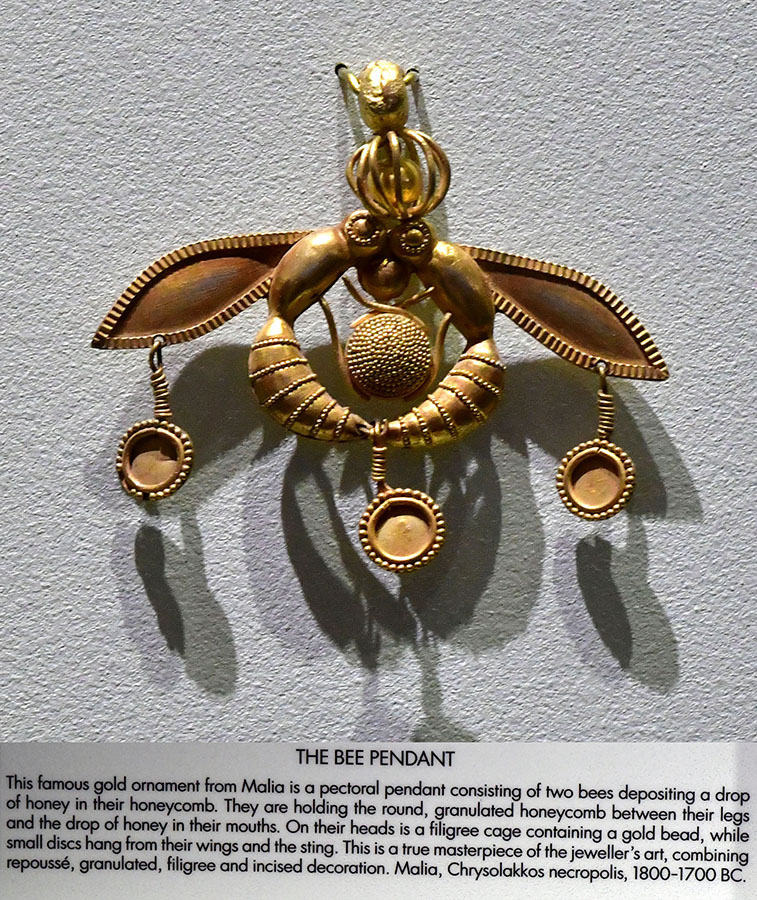
The emergence of palatial societies & palaces on Crete
Elaborate building complexes, known as the “First” or “Old” Palaces, were established at the center of large towns, which emerged in the beginning of the 2nd millennium BC. Parts of these early complexes, buried under new palaces built atop, have been identified and partially excavated at Knossos, Phaistos, Malia and Petras. They include dining areas, large assembly and ceremonial halls, storerooms and a central court.
Gold-sheathed luxury weapons, scepters of authority, and precious jewelry also functioned symbolically, stressing the social status power and prestige of the palatial elite.
Writing was adopted to record goods, and complex sealing methods were developed, to ensure conformity of commercial transactions with the guarantee of the palatial administration.
Society was structured hierarchically with different skills and activities. Figures weaving on looms, potters and hunters are depicted on seals, while images of sailing ships reveal the presence of mariners. Some ancient figurines, ornate offering vessels and the remains of animal sacrifices show that the cult culture existed in palatial and domestic contexts. The “Old” Palaces were destroyed by fire circa 1700 BC.
Vases and decorations of the palace & houses of Knossos
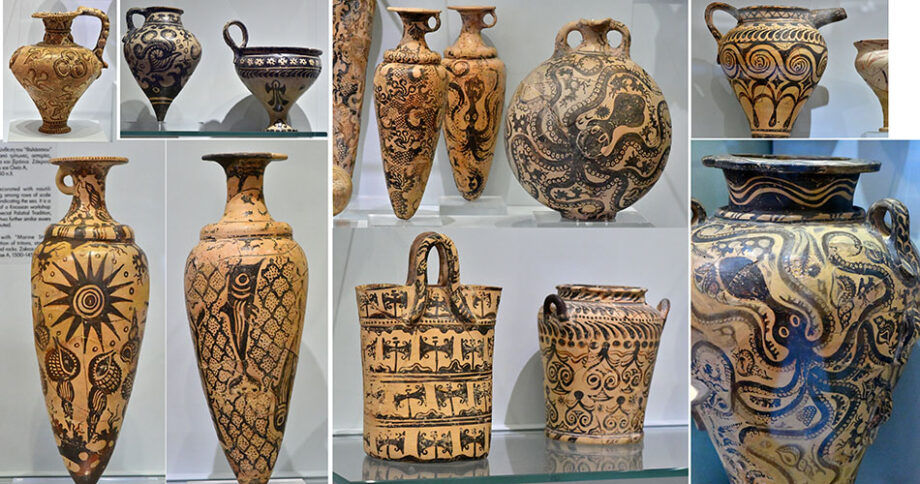
In the times of greatest prosperity, Minoan ceramic art reached its peak. The found objects of exceptional quality were produced in specialized workshops for the use of the ruling and prosperous urban class in the palace and town of Knossos. Stone lamps and vessels with elaborate relief decoration, bronze vessels, and vases with raised pictorial compositions or inlaid and covered in fine gold leaf, served practical and ceremonial purpose. The dark-on-light decoration dominated local pottery.
This is the pottery of the so-called “Special Palatial Tradition“, produced by palatial Workshops, mainly at Knossos. These elegant vases are decorated with geometrical and stylized motifs, and with nature and sea-inspired subjects named the “Floral Style” and the “Marine Style”. Exquisite vases were created by gifted artists such as “Reed Painter”, “Olive Spray Painter”, “Marine Style Master” and “Octopus inter”, whose works have also been found beyond Knossos on Crete.
Wine & Symposia at the Palace of Phaistos
Polychrome Kamares Ware vessels were used in palace banquets that attest to the opulent lifestyle of the palatial ruling class through their quality, quantity and astounding decorative variety.
Beautiful vessels found in the Phaistos palace are excellent examples of the so-called Kamares ware, a colorful decorative style that’s common for the palatial ceramic production during the First Palaces period. Decorations on these vases show similarities in painted motifs, like the chequerboard, spirals, and rocks. The vases were probably the products of one workshop that could have been made as a custom ‘dinner set’ for banquets and ceremonies of the ruling class at the Phaistos palace.
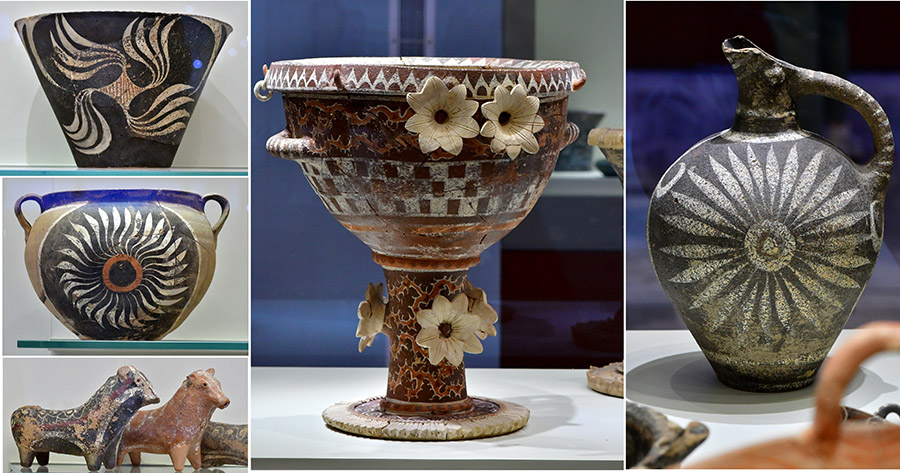
Among the vessels we can see a large crater standing on a high foot that could have been the vessel for mixing and drinking wine in large quantities. The offering of wine to a deity and group consumption of wine at banquets seems to be central to secular and religious rituals in the communities of prehistoric Crete. We can imagine the euphoria that prevailed at such banquets. This feeling could have been exacerbated by the visual stimulus of the decorations on these vessels. Painted spirals had a vivid, swirling movement with color intensity of polychromies used on vessels of the Kamares ware.
In this particular case, the luxurious ‘dinner set’ of the Phaistos palace rivals the vessels used in Knossos for similar symposium ceremonies at that time period. We might discern a demonstration of power of the palace’s ruling class through these luxurious vessels. It could have been an attempt at cohesion of local communities through these opulent banquets. This was an era of competition between palaces that would lead to the emergence of Knossos as the first power on the island during the next period of New Palaces.
The Minoans of Crete were pioneers in the production of the famous purple dye known today as Tyrian purple.
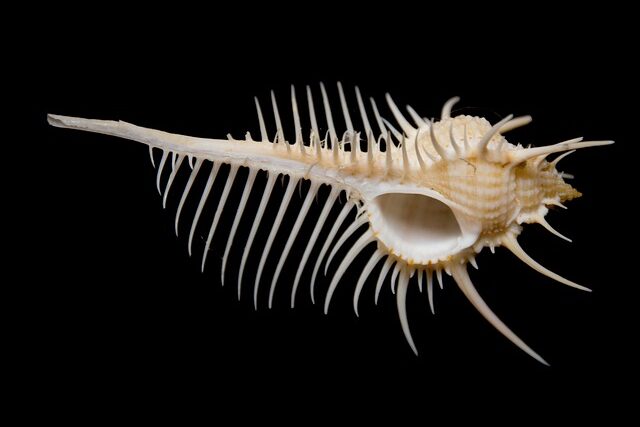
The Minoans obtained the dye from murex sea snails, similar to the Phoenicians who later became famous for it. Archaeological evidence suggests Minoan production dates back to the Middle Minoan period (2000-1600 BCE), predating the Phoenicians by centuries. Discoveries of large quantities of crushed murex shells at sites like Chryssi Island in eastern Crete point to dedicated dye production facilities. The Minoan purple dye likely possessed the same rich, deep color and remarkable lightfastness (resistance to fading) that made Tyrian purple so valuable. The extraction process was laborious, involving the collection and processing of vast numbers of sea snails. The resulting dye was incredibly expensive due to the difficulty of production. Minoan purple likely colored textiles and other luxury items, signifying wealth and status. It’s interesting to note that while the Phoenicians later became synonymous with this purple dye, the Minoans may have been the true innovators behind this remarkable ancient technology.
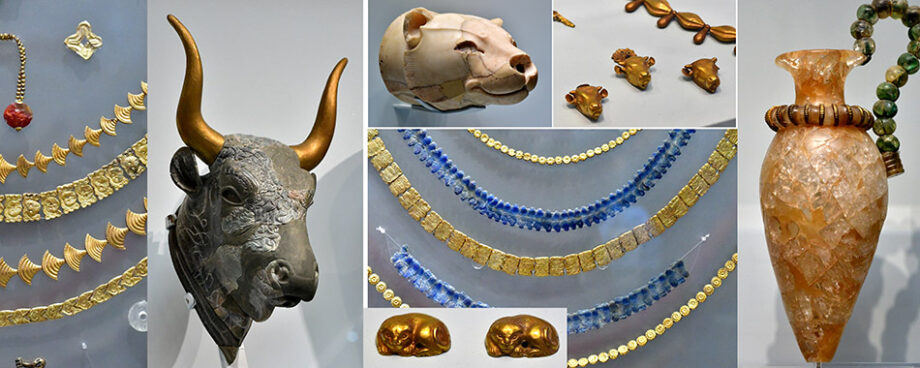
The Palace of Minos in Knossos
The following information comes from the descriptions found inside the museum. I reworked it for better reading experience.
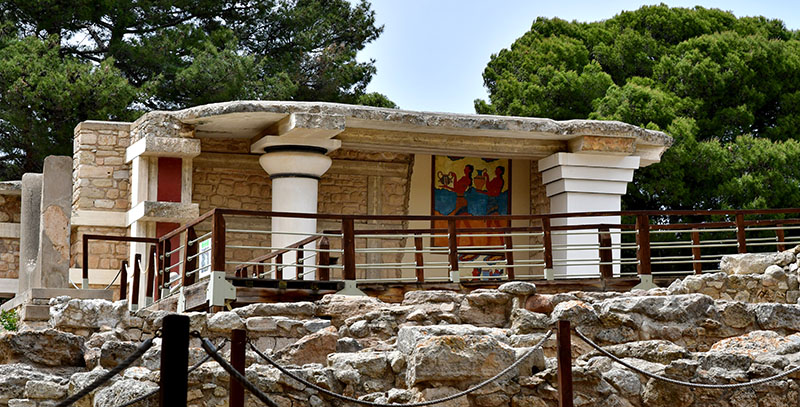
The Palace of Knossos is the largest palace on the island of Crete. The palace is surrounded by an extensive city. The Palace was built on the low Kephala hill at the confluence of two streams. This location determined the subsequent growth of the settlement because of its proximity to the sea and rich soil of the region. The extensive settlement appeared during the Neolithic period (6700-3200 В.С.).
The First Palace was built around 1900 B.C. (Old Palace Period). It appears that the basic floor plan appeared at that time based on few, preserved parts today. This first palace got destroyed around 1700 B.C. and the New Palace was built in its place (New Palace Period). With the exception of some later additions, Arthur Evans uncovered and restored its ruins.
The New Palace consisted of different buildings surrounding the Central Court. There were multiple entrances, including the formal southwest and north ones. The West Wing includes shrines, official halls and extensive storage areas, and the East Wing, the “Royal Apartments” and workshops. There were storage rooms and other areas to the north and south.
Architecture:
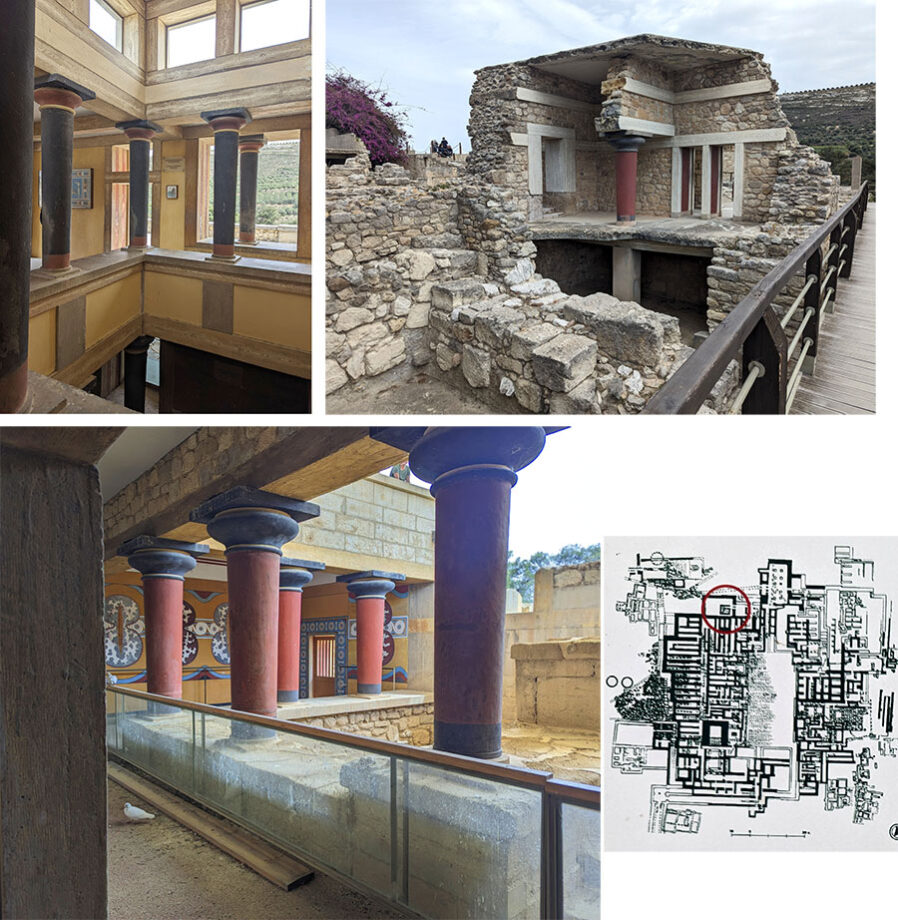
The Palace displays a great variety of architectural features. Multi-storied buildings had flat roofs on different levels. They had the indented or protruding facades. The embellishments included stone horns and multi-colored surfaces. The Minoans used a variety of materials, like green schist’ slabs on the floor, wooden columns, and gypsum slabs on walls and construction elsewhere. Polychrome plaster and wall paintings contributed to room decorations.
Minoan architects broke new ground in both planning and construction techniques of their buildings. They developed the palaces and buildings with palatial features and the Palace in Knossos became the epitome of Minoan architecture.
An emblematic Minoan innovation is the “polythyron hall” with pier-and-door partitions and light wells offering various combinations of circulation, lighting and ventilation. Another pioneering invention is the addition of wooden columns to the façades, forming colonnades and balconies looking onto the great courts. The crowning achievement of the design is the ‘Grand Staircase of Knossos,’ with its 2 flights of stairs supported by columns on each floor. A dense grid of timber frames ensured the construction stability.
The Minoans used raised stone and painted plaster elements of doorways and floors, in particular gypsum (alabaster) on the floors and ashlar masonry on the façades. Its architectural complexity, maze-like interior, shifts of light and shade, gave rise to the myth of the Minoan Labyrinth. Besides the palace itself, elements of palatial and urban architecture are depicted in wall paintings, clay models and the plaques of the “Town Mosaic.”
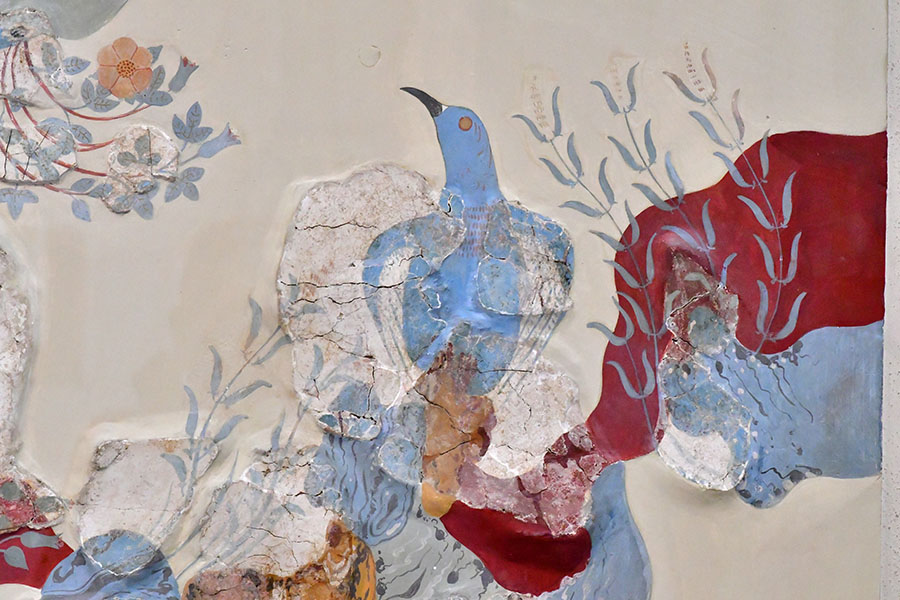
The Palace appears to have been the center of political, economic and religious authority. Main archeologist, Sir Arthur Evans, attempted to interpret the function of the spaces in the Palace and gave them names that reflected their use according to his opinion. This was based on the finds, mythology, and analogies with ancient civilizations during his time. These names are still the same, like the “Queen’s Megaron” [hall], “Piano Nobile” [upper floor], “Throne Room”, etc. Although a continued research has put forward different views on the function of some areas.
The Palace of Knossos continued its use after the 1450 B.C. even when the rest of the Cretan palaces were already destroyed. Most experts believe that new inhabitants came from the Mycenaean Greek mainland and settled in the Palace, thanks to the discovery of the Mycenean archive of Linear B script. It remains unclear when the Palace ceased to function. The significance of its former glory got lost after the 1380 B.C.
The North Lustral Basin
This room resembles a cistern. Reached by steps, its floor is lower than the surrounding area. Many columns surrounded the “Lustral Basin” and were lined with slabs of gypsum, giving it luxurious appearance. The area in its present form has been reconstructed by Evans.
Other parts of the Palace of Knossos have similar rooms. Moreover, other palaces and Minoan buildings of this period (1700-1450 B.C.) have the same structure. The use of such cistern-like areas is unknown. However, based on their construction, the rooms were not filled with water and had no drainage system. Evans thought that they were used in purification ceremonies and thus called the “Lustral Basins”. Evans also believed that the Palace was a sacred place. In his opinion, the “Lustral Basin” in question was used to purify visitors going into the Palace via the neighboring North Entrance.
West Magazines
By looking down, you can see the beginning of the corridor that joins 18 long and narrow storerooms, covering an area of 1300 sq. m. (Fig.1). There were found 93 rectangular cists, “Kassellas” on the floor of storerooms and corridor. They seemed to be used for safe-keeping of precious equipment and vases.
The excavations also found large cists in the corridor that probably held the liquids. Εικ. Fig. 1. The pithoi (large storage jars) (Fig.2) of the “West Magazines” bear witness to the wealth of the Palace. The remains of about 150 pithoi were found, although there is room for about 400. The contents stored inside are unknown, although they could have been oil, wine, etc.
The archeologists also found clay tablets in this area. These clay tablets have writing in the Linear B script with records of local economy. They also discovered a large number of older clay seal impressions and clay tablets written in the Cretan Hieroglyphic script located at the north end of the corridor.
The West Porch
The West porch or the Corridor of the Procession was an open area with a roof facing the court. It was supported by one column, from which part of a gypsum base exists today. The east wall was decorated with a fresco depicting a leaping bull. A small guard room was adjacent to the porch in the back. The porch was closed off by a double door from where the long Corridor of the Procession began. It got its name from a wall fresco there depicting a procession of musicians and other people with gifts. A well-made floor continued to the central Court.
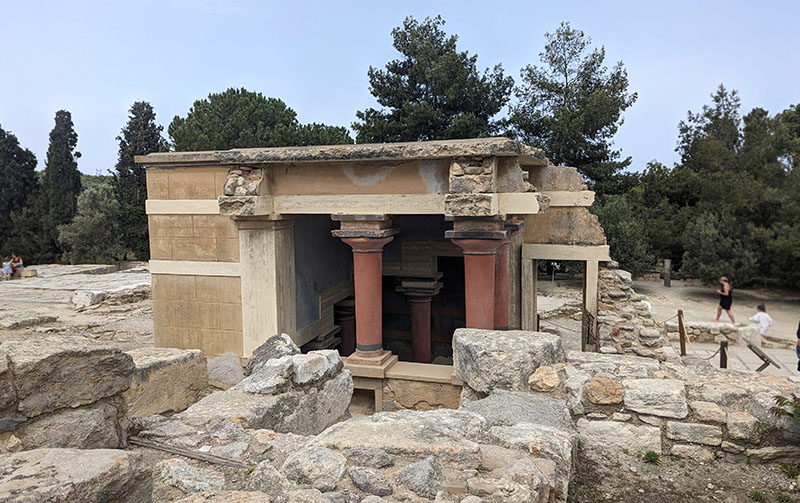
The West Court
Built of some massive gypsum blocks, the West Facade of the Palace rises up on one side that may have been used in ceremonies. The found settlements below this area belong to the Neolithic (6700-3200BC) and Pre-Palatial periods (3000 BC).
The Great Staircase
The great staircase and the upper floor to which it leads is largely Evans’ creation. Evans thought that it had a function similar to the first floor of the Italian Renaissance Palazzo, which was called the “Piano Nobile”. In this instance, he thought that the reception rooms of the Palace would be on the upper floor.
Evans also thought that there was the “Tri-Columnar Shrine” with a Treasury inside the Palace. The basis for his view lies in findings of collapsed ritual stone vases on the ground floor and the column and pillar bases. The rectangular building standing next to the stairs was built much later after the destruction of the Palace. Evans interpreted it as a “Greek Temple.”
The Figure-of-Eight Shields fresco
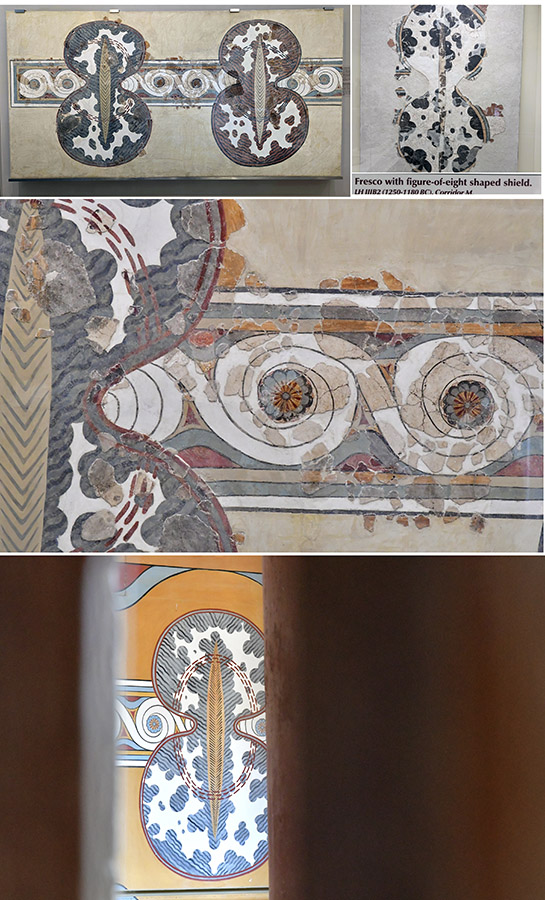
The fresco with “Figure-of-Eight Shields” repeated in a stylized row, decorated the walls of the loggia of the “Grand Staircase,” leading to the official quarters of the palace. The fresco depicts the actual shields suspended on walls. They were made of either a wooden or metallic framework covered with ox-hide, represented by the dappled surface. The shields may have represented the military power of the Knossos palace’ ruler.
Knossos, Palace, Final Palatial period (1450-1350/1300 BC).
The Ladies in Blue fresco
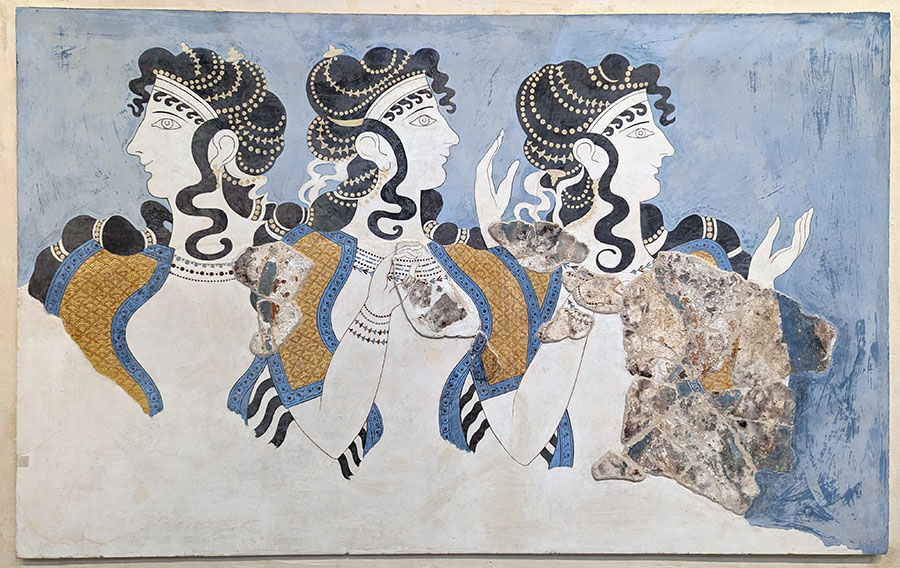
Knossos, Palace, Neo palatial period (1600-1450 BC).
The Griffins fresco
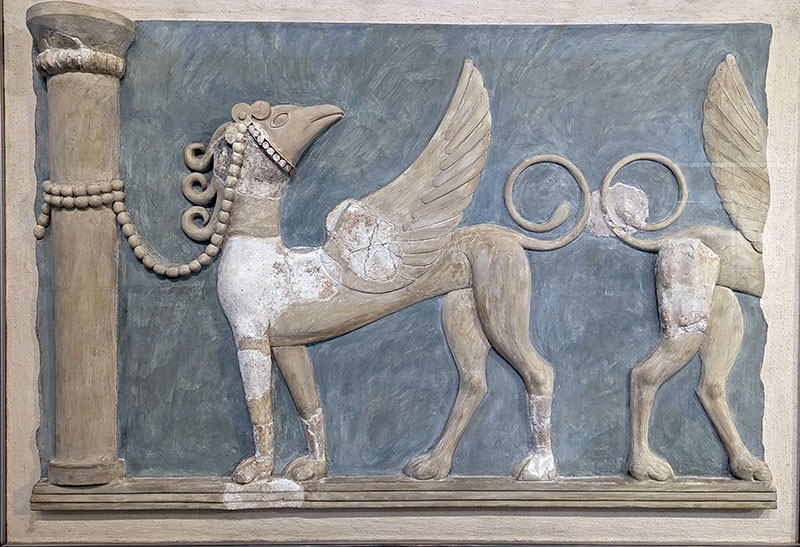
The Griffins fresco done in high-relief and tethered to columns decorated the “Great East Hall” of the palace of Knossos. The decoration of the hall also included religious emblems and representations in relief of boxing and bull-leaping games. According to Arthur Evans, this hall, located next to the “Grand Staircase”, was used for official ceremonies by the palace rulers. Knossos, Palace, Neo palatial period (1600-1450 BC).
Prince of the Lilies fresco
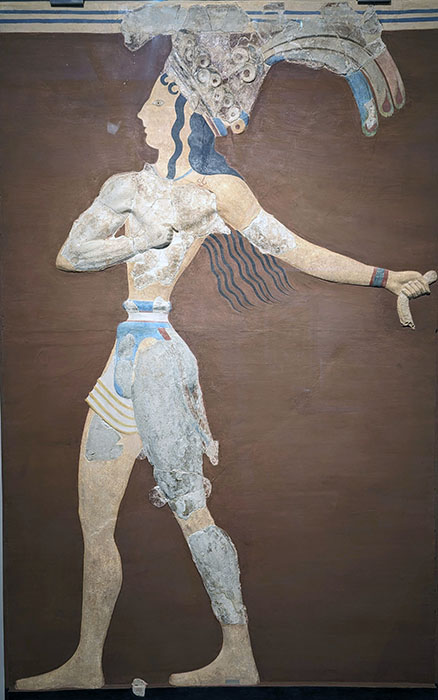
The “Prince of the Lilies” is a high-relief fresco of a large mural. It’s emblematic image of Minoan Crete. The life-size figure is composed of three non-joining parts. He wears a richly colored kilt with a codpiece and belt. He wears a crown made of papyrus-lilies and peacock feathers. According to the excavator of Knossos, Arthur Evans, this figure was the “Ruler of Knossos”, the “Priest-King” and a personification of religious and secular authority. However, other scholars suggest different reconstructions and interpretations, according to which the “Prince” may be an athlete, a boxer, or a commanding ruler, while the crown is attributed to a priestess or a sphinx. Knossos, Palace, Neo palatial period (1600-1450 BC).
South Entrance, Corridor with the “Prince of the Lilies” fresco
The south part of the Palace has significant erosion. We can only see the foundations of the tiered levels. A tower-like projection is the only remaining part of the south entrance to the Palace. An ascending corridor led to the Central Court. The reconstructed corridor is the closest to the Central Court in the Palace. Evans put a copy of a relief wall painting here, of which only a few fragments were found (Fig. 1). The fragments showed a male figure wearing lily-shaped jewelry. The reconstruction you see here is unresolved. In Evans’s opinion, the picture represented the ‘Priest-King’. Other scholars think that it is either a prince or a female figure.
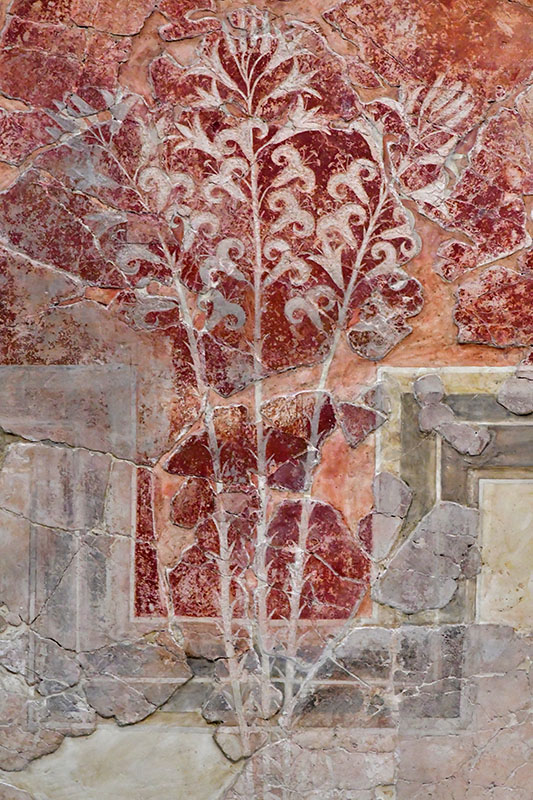
Wall paintings of the Throne Room
There are 2 parts of the fragmentary wall painting that decorated the “Throne Room” at Knossos. The first one depicts a couchant griffin and the second one a palm tree, the forelimbs of another griffin, and the altars. These paintings were placed next to the throne on the wall opposite the entrance of the room. These fragments enable the reconstruction of the entire scene, full of symbolic connotations related to the religious and ceremonial use of the room. The real alabaster throne is integrated in a riverside landscape. Stylized reeds are painted on the walls. Palm trees, symbolizing the regenerative powers of nature, spring from the base of the throne. The griffins flanking the throne have no wings, thus interpreted as the permanent guardians of the authority symbolized by the throne itself. Knossos, Palace, Final Palatial period (1450-1350/1300 BC).
The Knossos palace likely wasn’t intentionally built as a maze in the sense of a trap with a single, hidden exit.
It does have complex design. The palace at Knossos had multiple stories, winding corridors, and numerous rooms. This strange layout could be easily mistaken for a maze, especially after centuries of partial collapse and reconstruction. Archaeologists have uncovered over 1300 rooms! The legend of the Minotaur’s labyrinth likely originated after the palace’s fall. The myth provided an explanation for the palace’s confusing layout. King Minos, according to the myth, had the brilliant craftsman Daedalus build a labyrinth to house the Minotaur. The excavated structures show a purposeful design for a grand palace complex, not a purposely confusing maze. The palace housed royalty, administrative functions, various people, artisans, merchants, priesthood, and workshops. While complex, it likely needed to be navigable for daily life as a complex administrative center.
Administration & Economy: Linear B texts
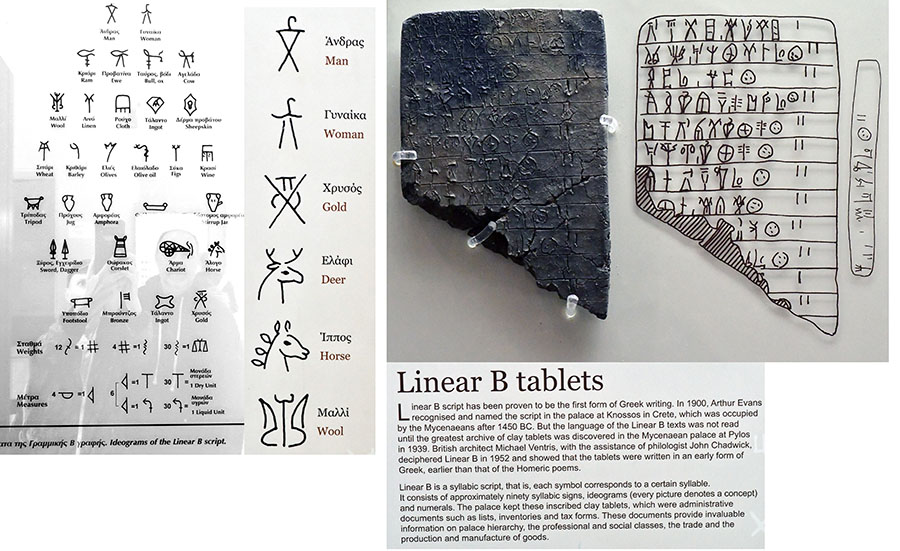

The 3,400 clay tablets inscribed in Linear B script from the palace of Knossos form part of the archives maintained by the new dynasty, which established itself at the palace following the destruction of most Minoan political centers in 1450 BC. In contrast to the preceding Linear A texts, which recorded the unknown language of the Minoans, the tablets written in syllabic Linear B script, date back to 1425-1300 BC. They are the earliest known texts written in Greek. They are temporary lists of accounts and recordings of goods, military equipment palace officials, dependents, and ritual offerings. They were incised into wet clay by 100 different scribes. Linear B texts got preserved by accident as they got baked in the fire that destroyed the palace.
The signs of Linear B script are derived from the Linear A script. Linear B has 89 syllabograms corresponding phonetically to syllables. They also include logograms, which were used as abbreviations of the commodities recorded, together with numerical symbols indicating quantities and units of weight and capacity. Long and thin “palm-leaf” tablets were used for individual registrations, while the rectangular “page” tablets were used for details and summary entries. Brief inscriptions are also found on sealings, i.e. lumps of clay stamped with seal imprints and used to label goods. Minoans labeled clay stirrup jars for transportation and storage of liquids, like olive oil and wine.
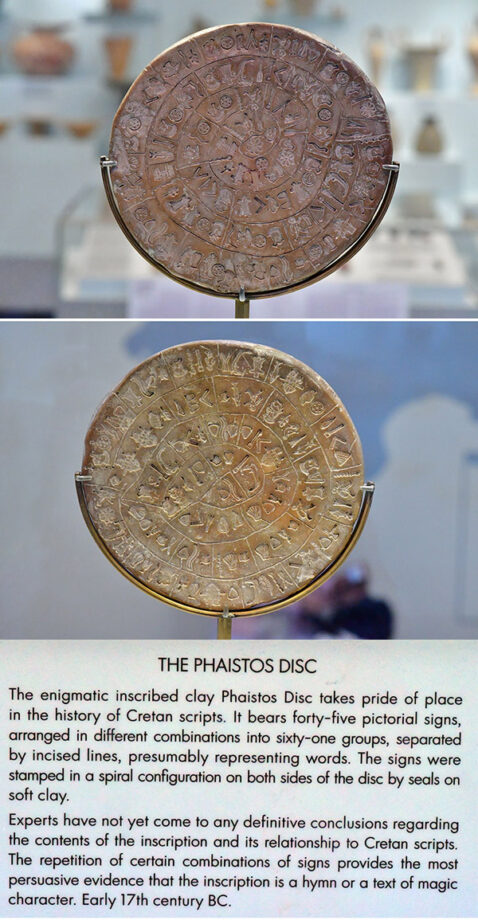
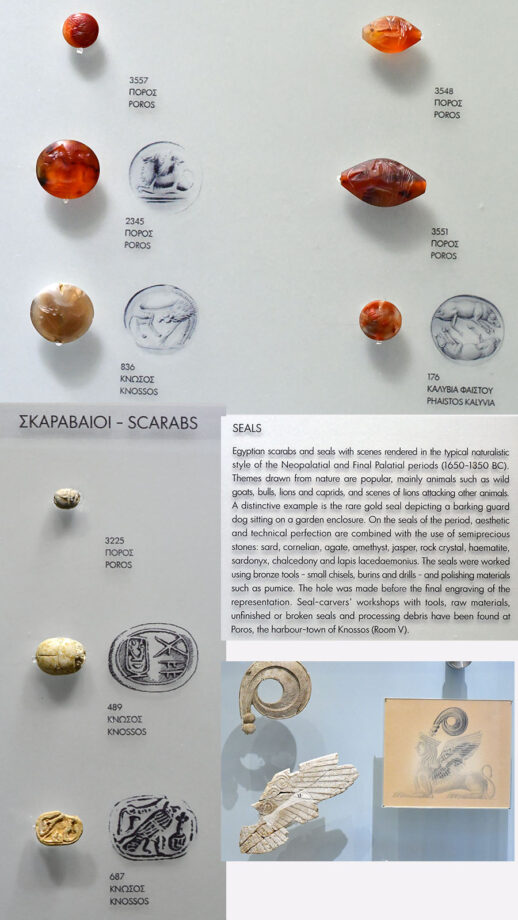
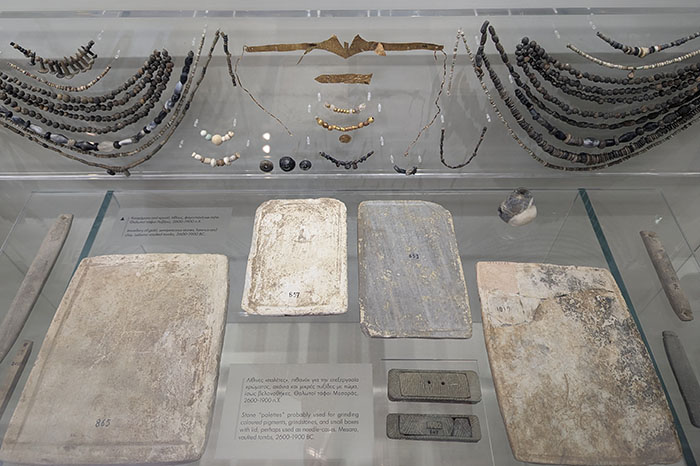
The Minoan Religion & the World of the Dead
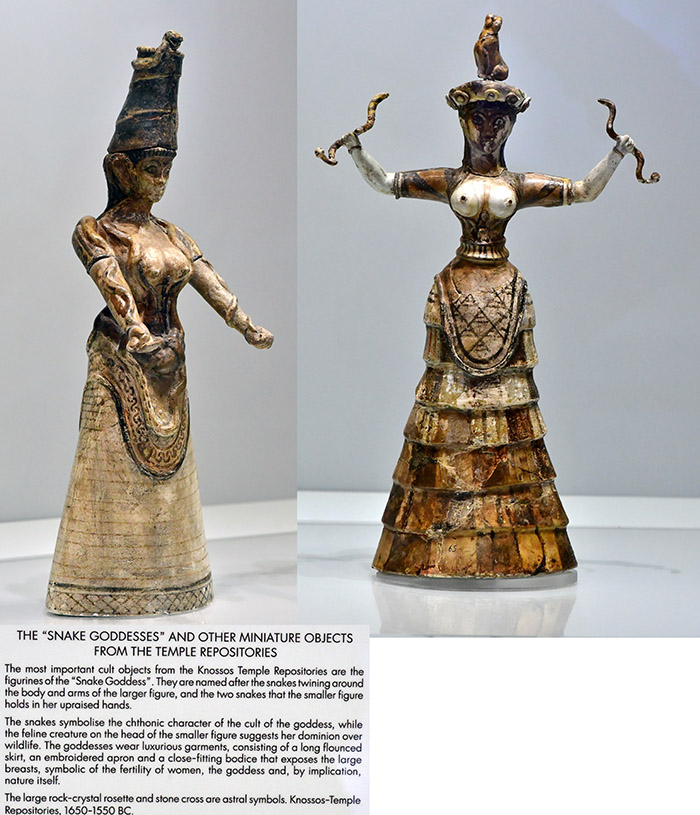
The Hagia Triada Sarcophagus
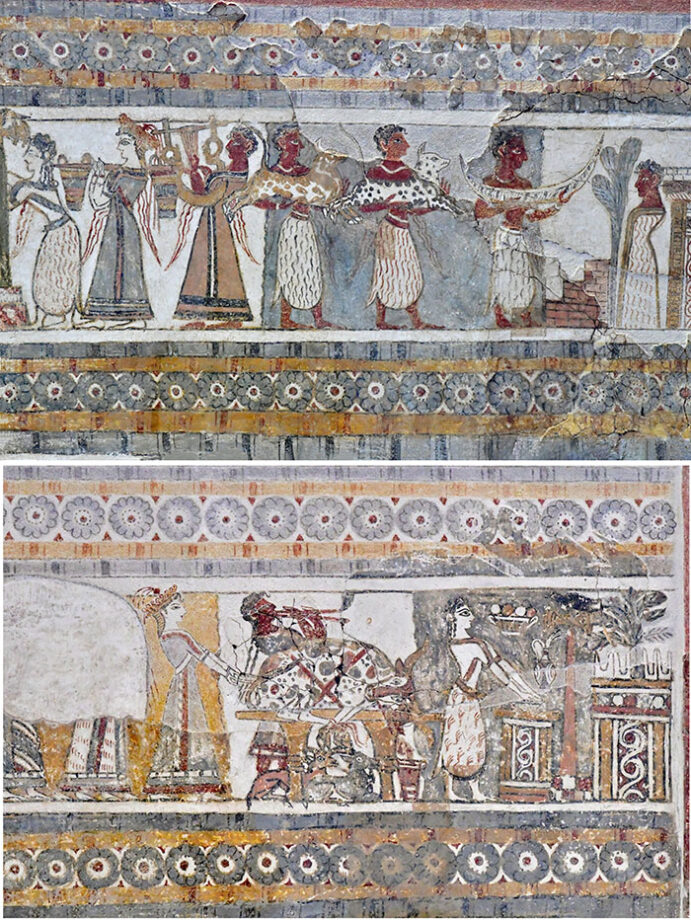
The Limestone sarcophagus depicts ritual ceremonies in honor of the dead and transcendental scenes associated with the afterlife beliefs. The scenes are frescoes painted on plaster. You can see a depiction of a dead man on one long side of the sarcophagus. He wears a long tunic, standing in front of a building that could be a tomb. He is receiving offerings of a boat and animals. On the left, priestesses hold a lyre are pour libations into a bucket set between the columns with double axes. Birds sit on the axes, symbolizing the deity’ presence.
Another long side depicts a bull’s sacrifice. The animal, trussed to a table, is being sacrificed to the accompaniment of a double flute and offerings made by a priestess at an altar. The altar is situated in front of a sanctuary crowned with horns of consecration. There is a pole with a double axe set between the sanctuary and the tree. The bird tops a double axe, indicating the epiphany of the deity. The two narrow sides have depictions of goddesses riding in chariots with griffins and horses or wild goats, and a procession of men. The sarcophagus was found in a rectangular built tomb and belonged to a ruler who, as the images narrate, was splendidly honored after his death by the palatial priesthood and the gods, on earth and in heavens. Hagia Triada, 1370-1300 BC.
The Larnakes
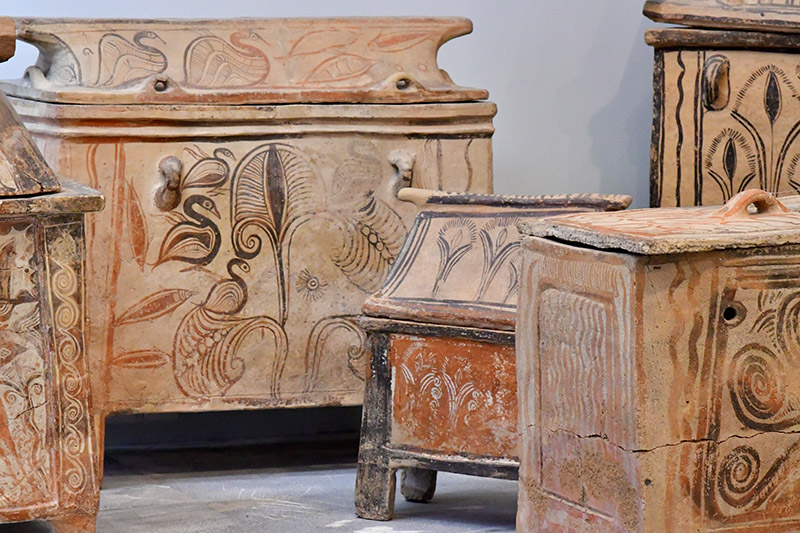
Clay larnakes imitate the wooden coffins. There are two types of the coffins. The first one is in the shape of a wooden chest with a gabled lid. The second one resembles a bathtub. The deceased were placed in a fetal position, perhaps signifying the symbolic return to the beginning of life in the womb.
Their iconography is, in a way, a continuation of the great fresco art that adorned the walls of the palaces. For example, the sarcophagus of Agia Triada was decorated in the same art style and technique as the frescoes. A complete narrative sequence, covering the ritual of the cult of the dead and Minoan perceptions and beliefs regarding the afterlife is depicted on its sides. Iconographic themes are mostly inspired by the plant, animal and marine worlds. They were rendered schematically without a narrative’ cohesion.
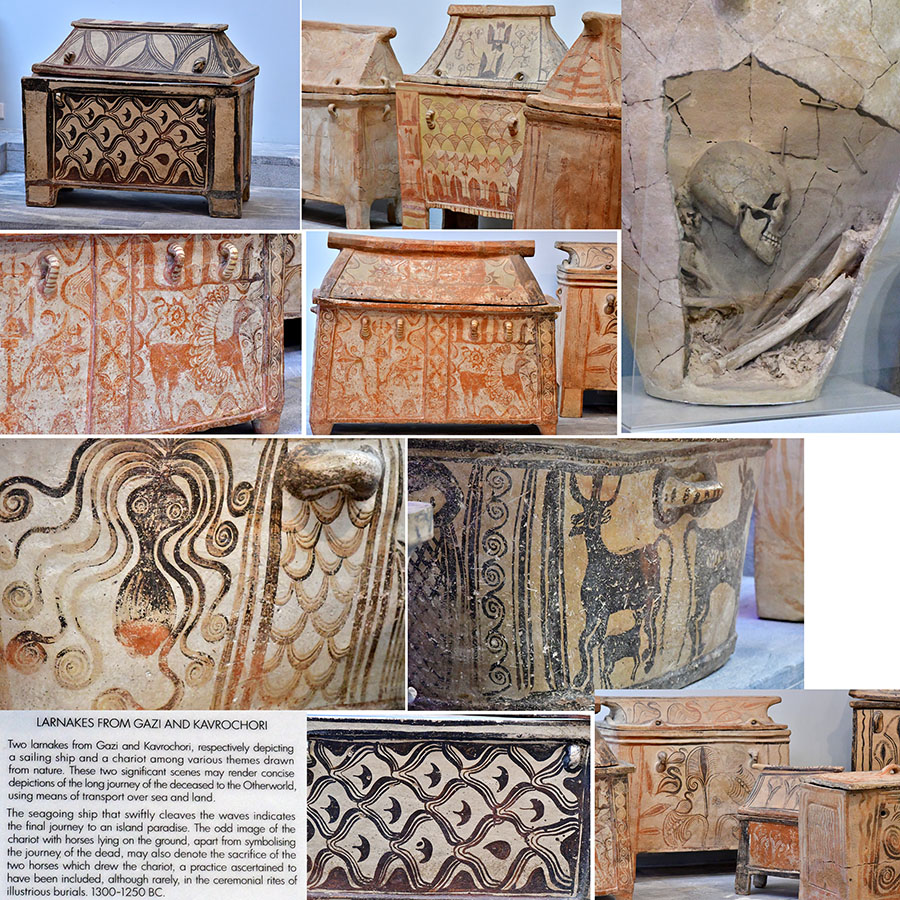
The obvious decorative aim of the motifs conceals a clear symbolic significance. These themes, isolated or in compositions, depict an abstracted version of the Minoan paradise. Marine creatures symbolize the sea across which lie the isles of the blessed dead and the Elysian Fields, according to the Homeric tradition. This otherworld of peace and eternal spring is indicated by trees, plants, birds and animals painted in dense juxtaposition on the larnax sides. The chariot and ship depicted on two larnakes show available transportation for a long journey over land and sea. Occasionally divine figures appear, the guardians of paradise, in attitudes of prayer or about to be enthroned, an image conveying the idea of the last judgement. These loose compositions, rich in meaning, are the final contribution of the folk painters of the Post palatial period to the pictorial art of prehistoric Crete.
The Warrior Graves and Graves with Bronzes, (1450-1300 BC)
Certain tombs, mainly in Knossos area, the sites of Zafer Papoura, Isopata Sellopoulo and the Venizeleio, contained a multitude of bronze weapons including swords, spearheads, daggers and halberds, as well as helmets. The most striking weapons include the swords with gold-covered hilts, gold nails and ivory pommels, intended as luxury and display objects.
They are insignia of the rank and status of an aristocratic warrior class which invested ideologically in the acquisition and use of weapons. The “Tomb of the Tripod Hearth” at Knossos, the Tholos Tomb A and the adjacent grave enclosure at Phourni, Archanes, andat Kalyvia Phaistos produced large assemblages of bronze banqueting vessels, such as cauldrons, jugs, bowls, washbowls, ladles and lamps. These items also functioned as markers of prosperity and social superiority. So did other grave offerings of gold jewelry, semiprecious stones, seals, bronze mirrors and implements, ivory objects and fine vessels.
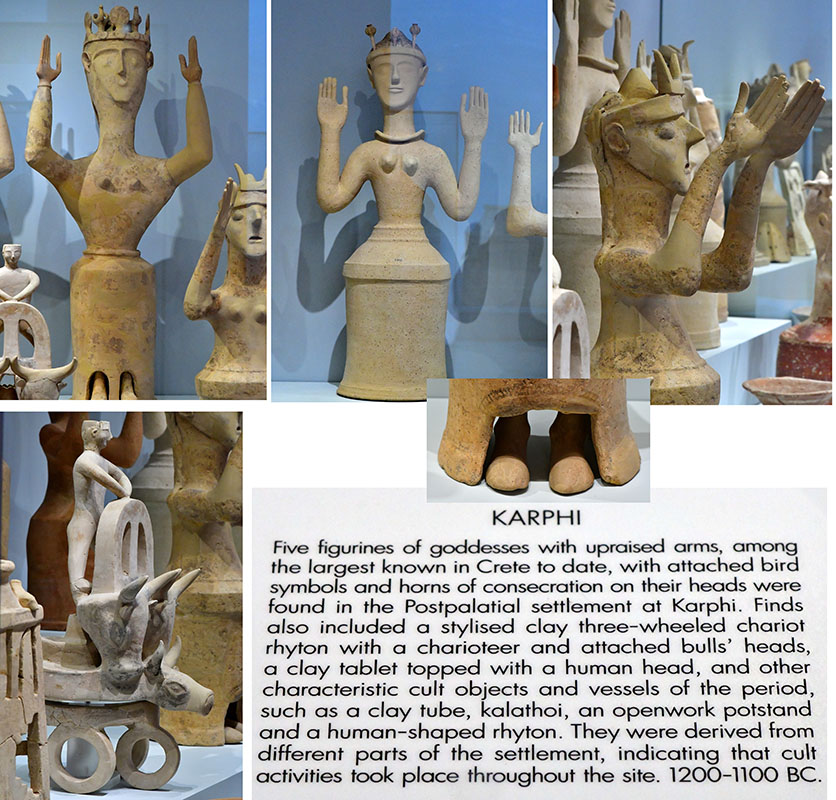
Five figurines with upraised arms, the goddesses, were found in the Post palatial settlement at Karphi. They have attached bird symbols and horns of consecration on their heads. The excavated artifacts also included a stylized, clay three-wheeled chariot rhyton with a charioteer and attached bulls’ heads, a clay tablet topped with a human head, and other cult objects and vessels of the period. They are clay tube, kalathoi, an openwork pot stand and a human-shaped rhyton. They were excavated from different parts of the settlement, indicating that the cult activities took place throughout the site.
Sacred symbols of a local cult
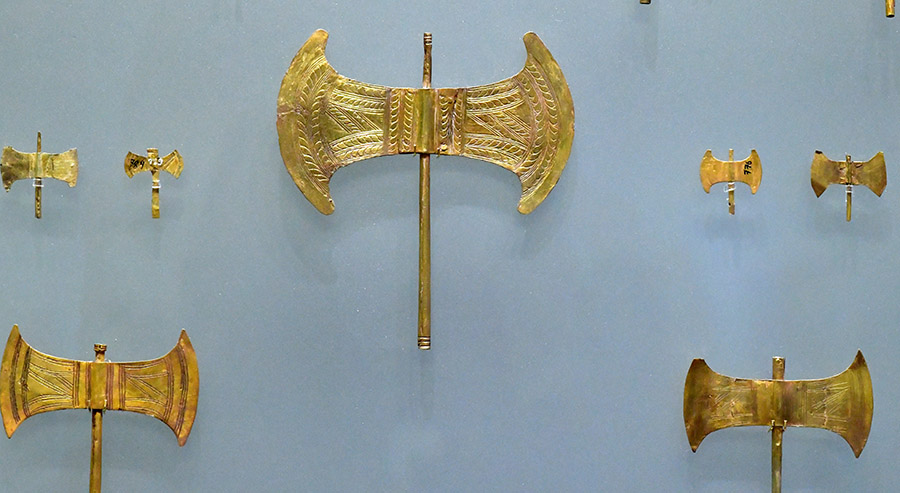
Small shrines in houses and peripheral administrative complexes served the needs of both a family and community. Open-air cult existed at some sanctuaries and in caves. Worshippers presented the deity with praying human figurines. Expertly crafted offerings for worship made of precious materials, such as bronze figurines, gold, silver and bronze artefacts, seals, jewelry, tables and stone vases- all became the ostentatious display of a person’s wealth. Such offerings are found in cult assemblages placed alongside numerous human and animal clay figurines. The realistic modelling of the bodies and the elaborate hairstyles of some male and female figurines highlight timeless social standards of men’s athletic bodies and women’s neat and elegant appearance. Three-dimensional clay models represent figures and images of official religious ideology, centered on the Epiphany of the Goddess, which arose in the palatial environment.
The Minoans used the religious symbols in depictions of religious significance or to mark the sanctity of spaces and buildings, in which they performed the cult acts. The emblematic symbol of the Minoan religion, the double axe, is probably derived from the real axe used to slay the sacrificial bull. Horns of consecration were also a sacred symbol, perhaps a schematic representation of the horns of the bull, the sacred cult animal. The sacral knot was made of cloth and served as a symbol of protection. The biconcave altar, a symbol of sanctity, was based on a real altar. The figure-of-eight shield may be an apotropaic symbol to ward off the evil.
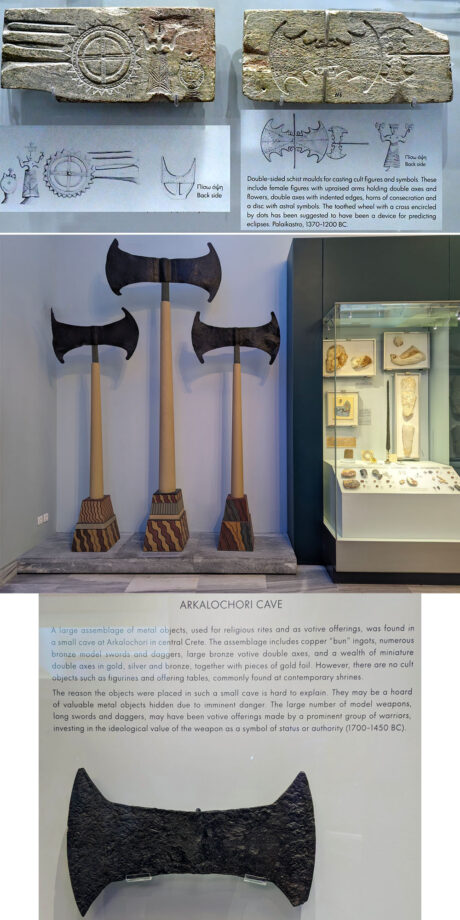
There are two different examples of unusual cult sites and sanctuaries presented at the Sanctuary at Anemospilia, Archanes, and the Arkalochori Cave.
The Arkalochori Cave
A large assemblage of metal objects, used for religious rites and as votive offerings, was found in a small cave at Arkalochori in central Crete. The assemblage includes copper “bun” ingots, numerous bronze model swords and daggers, large bronze votive double axes, and a wealth of miniature double axes in gold, silver and bronze, and pieces of gold foil. However, there were no cult objects found at this cave like the figurines and offering tables commonly found at contemporary shrines.
It’s hard to explain the reason for placing these objects in such a small cave. They may had been a hoard of valuable metal objects hidden from the imminent danger. A large number of model weapons, long swords and daggers, may have been votive offerings made by a prominent group of warriors. They could have invested in the ideological value of the weapon as a symbol of status or authority (1700-1450 BC).
Sculpture
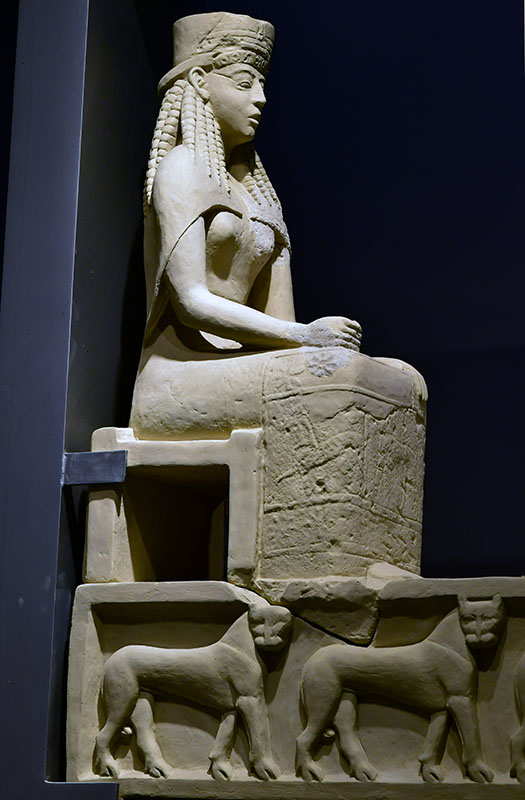
Greek art of the archaic period (7th-6th century BC) is marked by the development of monumental sculpture, namely the creation of life-size and over life-size statues in stone. Crete occupies a prominent position in the history of Daedalic sculpture of the 7th century BC named after Daedalus, the legendary craftsman and sculptor. The early date and the quality of the Cretan statues is the evidence of birth of Greek monumental sculpture on the island.
Following geometric period’s conventions for rendering the human features of the face and body, the archaic sculpture imprints human figures frontally. Such statues, especially the female ones, come from Astritsi, Eleftherna, Gortyna and other areas. Most Cretan statues were life-size made of local Cretan limestone. The island of Crete pioneers the development of architectural sculpture mostly used in the embellishment of temples and public buildings with statues and carved in relief representations. This decoration type can be seen in the temples of Prinias (possibly ancient Rizenia) and Gortyna.
At the end of the 6th cent. BC, the gravestones done in relief appear on the island of Crete. These gravestones marked the tombs of the dead, which were modeled after the Attic prototypes. Later on, the production in Crete decreases for political and social reasons.

Classical sculpture of the 5th and 4th cent. BC is represented by relatively few works of art (relief plaques and gravestones) showing Attic and Cycladic artistic influences. Rich artistic tradition of the island, however, has significant impact on ancient Greek art. Famous statues and architecture of the Hellenic world are attributed to two Cretan sculptors – Dipoinos and Skyllis, who were pupils of Daedalus.
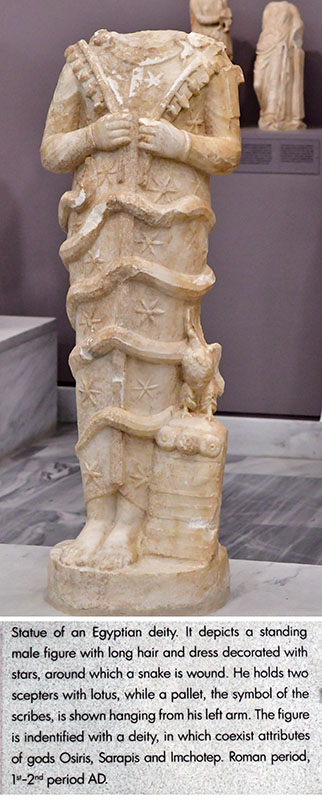
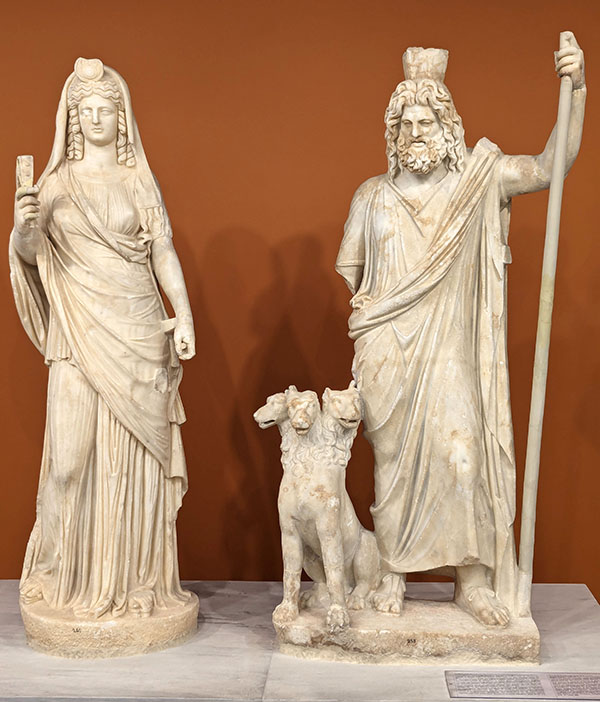
Group of statues with gods Pluto and Persephone, depicted as the Egyptian deities Sarapis and Isis, were worshiped in the Hellenistic period onwards in Greece. Pluto-Sarapis has the modius on his head, a utensil used for the measurement of grain. Persephone-Isis bears her symbols in the forehead, mainly the crescent moon, the solar disk and the snake (uraeus). She is depicted holding the sistrum in her right hand, an Egyptian musical instrument also known to Crete from pre-history. Her left hand holds the straps of the dog, Cerberus. The inclusion of Cerberus, the guardian of the underworld, into this group defines the two deities as gods of the underworld. The composition is a typical example of syncretism, the integration of beliefs from different religions during Hellenistic and Roman times. Gortyna, Temple of Egyptian Deities, Roman period, mid. 2nd cent. AD.
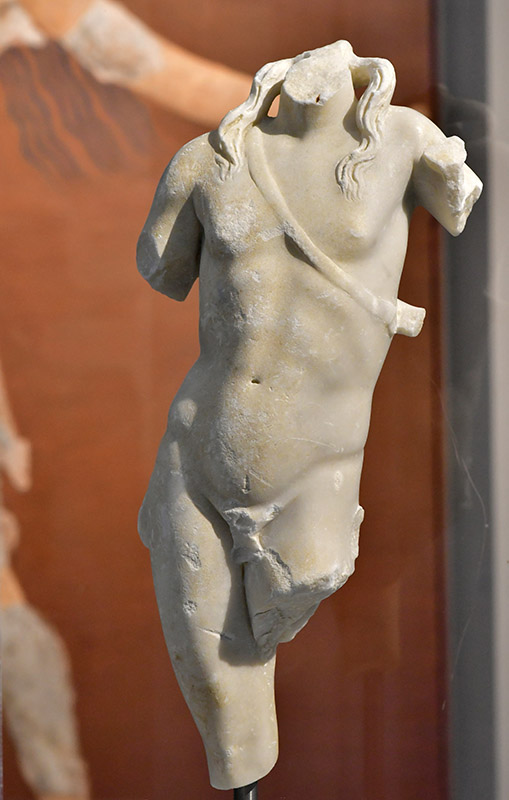
Athletes & Acrobats: Bull-Leaping
An important aspect of Minoan public life were organized spectacles at which trained athletes engaged in contests of strength, endurance, and skill. There were several very popular but dangerous contests: bull-leaping, bull-hunting, and boar-hunting. Minoans also had wrestling, boxing, foot racing, chariot racing, somersaulting and other sport games.
The most spectacular Minoan acrobatic sport was bull-leaping. Young but trained athletes made a dangerous leap over the horns and back of a charging bull. Athletes of both sexes participated in this sport as recorded in the color of their skin, dark for men and white for women. The bull-leaping extravaganza is depicted in a series of wall paintings, gold rings and seals characteristic of the Minoan culture on Crete. The contests would have been held in large, outdoor spaces or even in the courts of the palaces. The Minoans cultivated the spirit of competition and excellence in sports that was later adopted by the ancient Greeks in the Olympic Games. Large crowds of excited spectators watched the games in Minoan Crete.
The Bull-Leaping Fresco
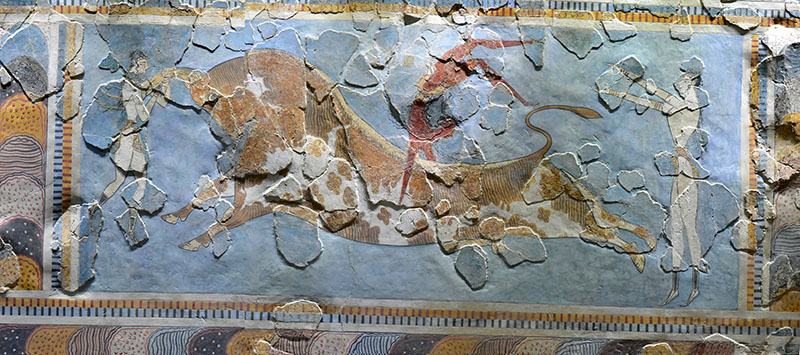
Beautiful places to see in Heraklion
- The Morosini Fountain at Lions Square was built in 1628. The 16th-century Bembo Fountain in Kornaros Square, central city of Crete
- The location of the Venetian Fortress is beautiful to look at turquoise water and city’s harbor.
- The city’s center has a few significant buildings and a church. In addition, the Agios Minas Cathedral is a must-see.
The Agios Minas Cathedral
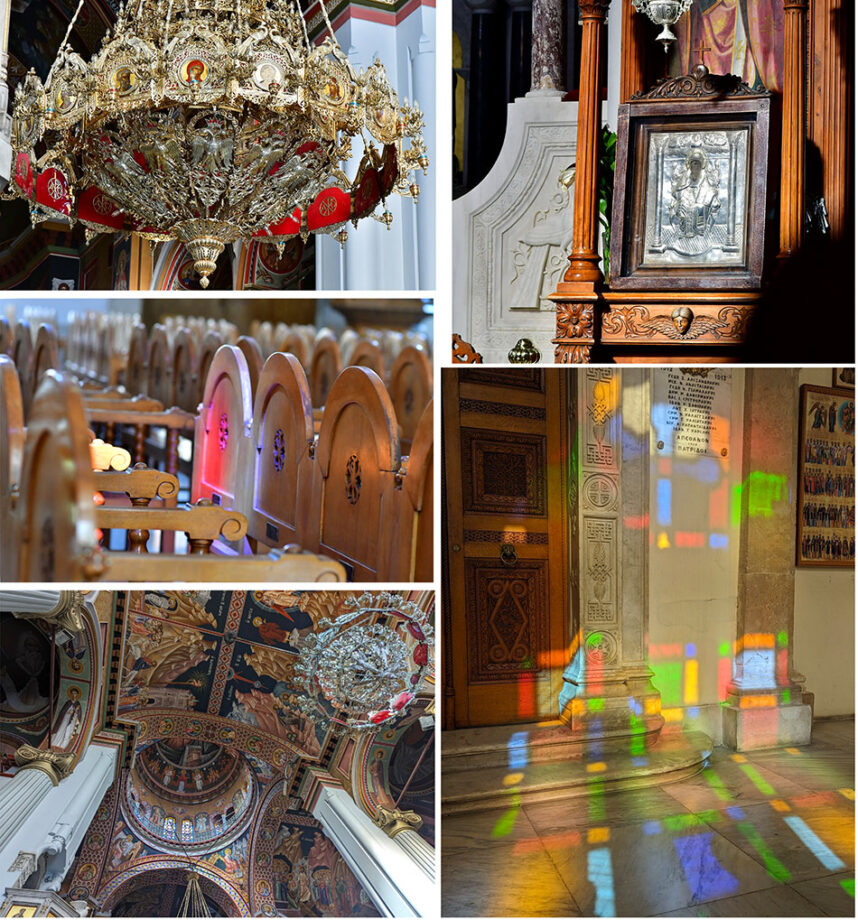
Built in late 19th century, this beautiful church is dedicated to Saint Menas, the martyr who lived around 285-309 A.D. The patron saint of Heraklion, he is depicted on a silver icon inside the church. The interior space is inspirational for anyone to see! It features colorful, byzantine-style murals and incredible chandeliers decorated with saints, double eagle and peacock designs. The stained-glass windows cast beautiful light on the walls and floor.
In conclusion, I hope I got you interested in visiting Heraklion, Greece to discover Knossos, the place and palace of the Minoan civilization on your own terms. As a reminder, the majority of this information comes from the museums on Crete. Visit the Heraklion Archaeological Museum for more information & tickets.
Greek art styles
Greek art is generally divided into four major periods:
- Geometric Period (900 – 700 BCE):
- Emerging from the Greek Dark Ages, Geometric art is characterized by its focus on geometric patterns and stylized figures.
- Pottery decoration is prominent, featuring abstract motifs like meanders, triangles, and swastikas.
- Human and animal figures are depicted in a simplified, geometric manner.
- Archaic Period (700 – 480 BCE):
- This period witnessed a shift towards more naturalistic depictions.
- Sculptors began carving figures in the nude, adhering to a rigid and idealized form known as the Archaic smile.
- Pottery decoration continued to evolve, with the introduction of the black-figure technique where figures are painted in black silhouette against a red background.
- Classical Period (480 – 323 BCE):
- Considered the pinnacle of Greek art, the Classical period emphasized balance, proportion, and realism.
- Human figures were depicted in more natural poses with a focus on ideal beauty and perfect anatomy.
- The red-figure technique dominated pottery decoration, with Greek mythological and narrative scenes.
- Famous Classical sculptors like Phidias and Polyclitus developed dominant styles portraying gods and heroes in idealized way.
- Hellenistic Period (323 – 31 BCE):
- Following the conquests of Alexander the Great, Hellenistic art embraced a wider range of emotions and expressions.
- Sculptures became more dynamic and dramatic, capturing movement and individual personalities, rather than idealized faces.
- Art from this period often reflected a more theatrical and emotional style.
- Genre scenes depicting everyday life gained popularity alongside mythological themes.
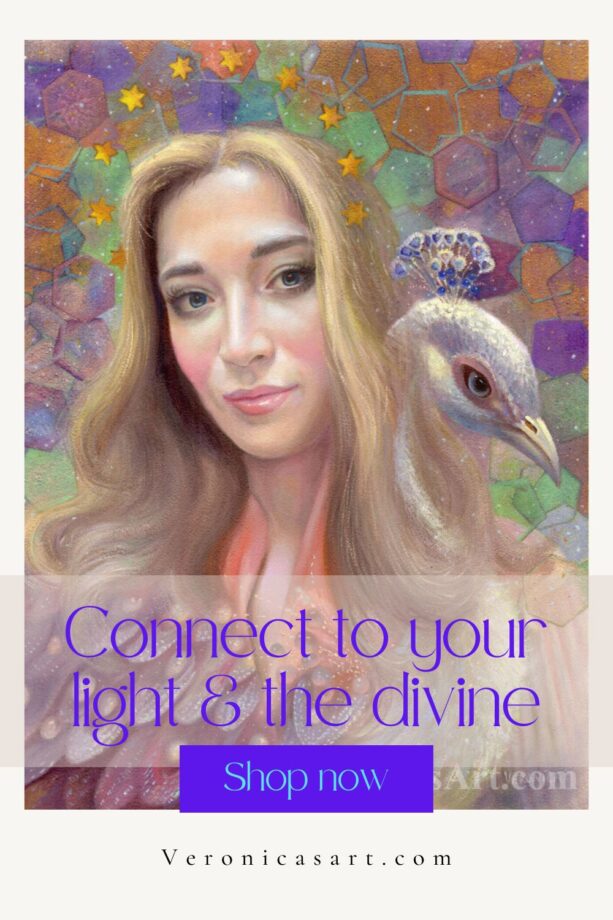
These art instruction books are on sale on Amazon!
